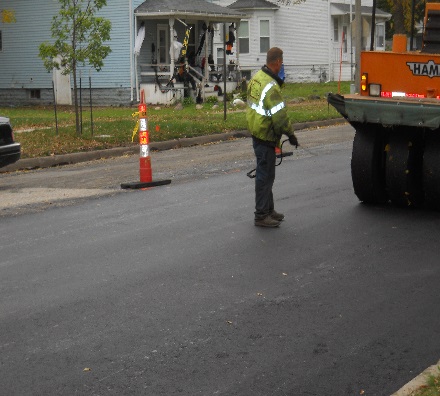On October 18, 2014, the construction of the leveling course for both HMA and WMA layers started. Foamed HMA mix was used as a leveling course for the WMA surface layer on the south bound of 3rd Ave. and the same HMA mix was used for both leveling and surface layers on the north bound of 3rd Ave. The WMA test section is located on 3rd Ave between 6th and 10th streets. A 3.0-inch asphalt layer consists of two sublayers; leveling layer with a thickness of 1.5 inch and surface layer with a thickness of 1.5 inch. The total length of the test section was 0.3 mile and the test section included 4.0% recycled asphalt shingles (RAS) by total mix weight of mix. The asphalt content of the RAS materials was 17.9% and, due to the lack of enough LEADCAP 6-8 (Pellets) WMA additive, a combination of LEADCAP 7-1 (Liquid) and LEADCAP 6-8 (Pellets) was used for the project (Originally, ENOVA was specified but, due to a long delivery time of ENOVA, LEADCAP was specified for this project). The traffic level for that project is low with approximately 1.0 Million EASL’s. WMA layer was constructed on the south bound and HMA layer was constructed on the north bound of 3rd Ave.
Foamed HMA Leveling Course during and after Construction



HMA Leveling Course during and after Construction



HMA Surface Course during and after Construction



WMA Surface Course during and after Construction



Material Properties
Asphalt binder with PG64-28 was used for all mixes and asphalt mixing temperature for the PG 64-28 was 155° C (311° F). Mixing and compaction temperatures are summarized in table below. The optimum asphalt content for both HMA and WMA mixtures was determined to be 5.3% and Both mixes contain 4.0% RAS with a 17.9% asphalt content. The binder replaced by the RAS is approximately 0.7% of the total asphalt content. Thus, the added asphalt content was 4.6% by total weight of the mix. The LEADCAP/RAPCAP additive was added to the asphalt tank then mixed with the heated aggregate. Foamed HMA (FHMA) was used as a leveling course under the WMA surface layer. The asphalt binder was heated to 310°F and the aggregate was heated to 290°F.
The target air voids during construction was 5.0 to 6.0%. A total number of 4 cores were collected from each lane to measure the filed densities of the test sections. The average air voids of the HMA, Foamed HMA and WMA test sections were 6.13%, 4.88 %and 5.88%, respectively. Tables below show the teperature and density data for HMA and WMA.
|
Binder Type |
Mixture |
Binder Temp. |
Mixing Temp. |
Comp. Temp. |
Density |
% Gmm |
% Air Voids |
|
PG 64-28 |
HMA |
310o F (155o C) |
310o F (155o C) |
285o F (140o C) |
2.315 |
93.87 |
6.13 |
|
PG 64-28 |
FHMA |
310o F (155o C) |
290o F (143o C) |
275o F (135o C) |
2.348 |
95.12 |
4.88 |
|
PG 64-28 |
WMA |
310o F (155o C) |
270o F (132o C) |
250o F (121o C) |
2.324 |
94.12 |
5.88 |
